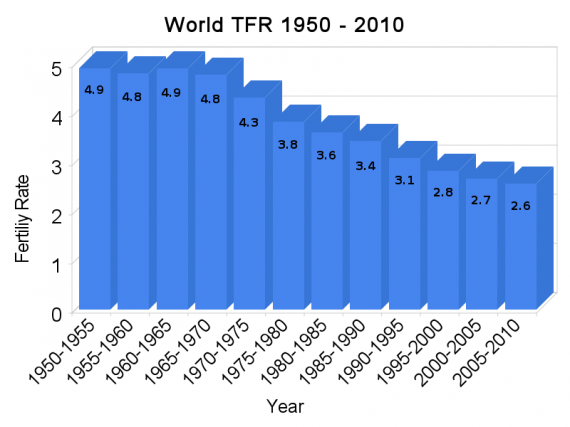Total Fertility Rate
In the last few decades there have been significant decreases in world fertility rates. The replacement fertility rate is roughly 2.1 births per woman for most industrialized countries but higher for many less developed nations. The Total Fertility Rate (TFR) of a population is the average number of children that would be born to a woman over her lifetime.
The chart below shows the World TFR in columns of 5 years, starting in 1950. The TFR for 2009 and 2010 are estimated. Take a look at the TFR chart below and the other statistics and join me in a discussion of what some of the trends and numbers may mean. For more insight into population trends try playing with the population database provided by the United Nations. Since writing this post the database has been updated and I now link to the latest available information.
Crude Birth and Death Rates
I will show you next a chart with world birth and death rates plotted together. This may prove useful to the discussion later. The Crude Birth Rate is simply the number of births over a given period divided by the person-years lived by the population over that period. It is expressed as number of births per 1,000 population. Likewise the Crude Death Rate is the number of deaths over a given period divided by the person-years lived by the population over that period. It is expressed as number of deaths per 1,000 population.
A Russian Demographic Example
This chart shows the Russian Federation’s demographic crisis quite plainly. All European countries have a TFR less than 2.1 and Russia’s at 1.37 is not the lowest. What is interesting about Russia is it has a sizable population and so their 12.3 million people loss since 1992 (offset by 5.7 million immigrants) is still large, even for a nation of 142 million. Today Russians are diminishing at the rate of over 700,000 a year. One wonders what the effect would be on any nation that suffers sustained population loss.
Decades Long Fertility Decrease
In my chart of world TFR there is plainly a decrease in every 5 year span since the early sixties. The rate of decline seems to be lessening in the last fifteen years but the trend is definitely downwards. The United Nations projects that by 2050 the World TFR will stand at 2.02. This is below replacement level for developed nations and well below a third world country.
Why Population Increases As Fertility Declines
The world birth/death rate chart shows births well above deaths, hence world population is increasing even as TFR is decreasing. Consider that between 1950 and 1955 the death rate was 52% of the birth rate. By 2005 to 2010 the death rate had dropped to 42% of the birth rate. However, even as the death rate drops so too does the birth rate. So why is the world population increasing even as the fertility rate is decreasing? Well, on average, each generation is having fewer children than the previous generation. That is explained by the fertility decrease.
To still have more births than deaths amid a fertility decline is easily accounted for in the decades long delay in the deaths of the parents and grandparents of newly born children. Hence even as the birth rate falls the parents who produced offspring are still alive in most cases and so the death rate is lower. This is called Demographic Momentum. After a number of decades the parents and grandparents die and their children now produce less babies as forecast by the TFR. Population decreases will now begin to appear as in the case of Russia when deaths outnumber births. It is then that the population drops will be in the millions.
Adverse Effects
One adverse effect of a declining population for the young is increased social and economic pressure. They will have to support an infrastructure with costly, intensive care for the oldest among their population. Labor shortages can occur which may cripple labor-intensive sectors of the economy. The decade long economic stagnation of Japan and Germany is linked to demographic problems. Russia has begun a 10-year program to stop the large decline in their population by offering financial incentives and subsidies to encourage women to have children. Australia, France, Italy, Poland, Japan, and Singapore offer thousands of dollars for each baby and regular payments and care for the child.
It is evident that a number of countries see declining birth rates as a serious issue — enough to offer incentives for reproduction. This is not going away anytime soon, especially for nations that have difficulty attracting immigrants. The United States would have a declining population if not for immigration. If the U.S. birth and death rates ever become like Russia’s you will hear more than you ever wanted to know about the total fertility rate.
A Third Way
Phillip Longman of the New America Foundation writes briefly of A Third Way. He states that “a planet that grays indefinitely is clearly asking for trouble.” One alternative to our current aging populations “involves massive state intervention designed to smooth the tensions between work and family life to enable women to have more children without steep financial setbacks.” Longman writes that “so far, countries that have followed this approach have achieved only very modest success.”
Longman then asks: “So is there a third way?”
Yes, though we aren’t quite sure how to get there. The trick will be restoring what, in the days of family-owned farms and small businesses, was once true: that babies are an asset rather than a burden. Imagine a society in which parents get to keep more of the human capital they form by investing in their children. Imagine a society in which the family is no longer just a consumer unit, but a productive enterprise. The society that figures out how to restore the economic foundation of the family will own the future. The alternative is poor and gray indeed. (Phillip Longman, “Think Again: Global Aging,” New America Foundation, October 13, 2010, last paragraph)
A Proclamation to the World
A fascinating document, in support of the family, flowered into existence on 23 September 1995. Entitled The Family: A Proclamation to the World, it was first read in a general Relief Society conference.
The proclamation begins by solemnly proclaiming that marriage between a man and a woman is ordained of God and that the family is central to the Creator’s plan for the eternal destiny of His children. Further, we all are created in God’s image and that gender is an essential part of human identity before, during, and after life on Earth. A summary is outlined of the premortal realm, perpetuation of family relationships beyond the grave, and of temple ordinances and covenants. Now here is the part that most pertains to our discussion:
The first commandment that God gave to Adam and Eve pertained to their potential for parenthood as husband and wife. We declare that God’s commandment for His children to multiply and replenish the earth remains in force. We further declare that God has commanded that the sacred powers of procreation are to be employed only between man and woman, lawfully wedded as husband and wife.
The proclamation continues by identifying parental responsibilities in the rearing of children. To teach them to love and serve one another, to observe the commandments of God, and to obey the law. A formula for happiness and for a successful marriage is detailed. And would a proclamation be complete without a warning?
We warn that individuals who violate covenants of chastity, who abuse spouse or offspring, or who fail to fulfill family responsibilities will one day stand accountable before God. Further, we warn that the disintegration of the family will bring upon individuals, communities, and nations the calamities foretold by ancient and modern prophets.
We call upon responsible citizens and officers of government everywhere to promote those measures designed to maintain and strengthen the family as the fundamental unit of society.
Summary
For decades our minds were filled with government propaganda of a world starving to death and grossly overpopulated with the West running out of food. Even today we hear similar cries. I find it ironic that many of these same governments are now offering thousands of dollars to their populace if they would just have a baby — or maybe two, or three. My wife and children — and now grandchildren are a constant source of joy to me. I am grateful that I followed the wise counsel of religious leaders (and ignored the politicians and “experts”) many years ago.
I am a software engineer by trade and know very little about world fertility rates. But the best way to learn is to write about it and discuss it. I look forward to your comments whether or not you agree with me.
Sources
- Population Division of the Department of Economic and Social Affairs of the United Nations Secretariat, World Population Prospects: The 2008 Revision, Population Database, October 19, 2009. The updated link points to the latest data not available when this post was published.
- Find your country in the UN TFR Ranking or the CIA TFR Ranking.
- World Population Growth Rates: 1950-2050 — From the U.S. Census International Database.
External Articles
This list is updated occasionally, with newer additions listed first.
- About That Overpopulation Problem — Facing a declining world population.
- Daring few challenge China’s 1-child limit — “I don’t think having a baby is any kind of crime.”
- A tale of three islands — World population reaches 7 billion. Don’t panic.
- World population — Boom to bust? — World EFR is 2.4, barely above the 2.3 replacement rate.
- Selective abortions creating imbalanced world population — Unnatural selection.
- Aging Population and Gender Imbalance Challenge China’s One-Child Policy — But no change.
- The End of Japan as an Industrial Power? — Japan’s workers will drop by 20% in 20 years.
- Global Aging And The Crisis Of The 2020’s — Population trends mean a more dominant US role.
- India’s Secret Weapon in its Economic Race With China: Demographics — When? Around 2030.
- Think Again: Global Aging — How did the world get so old, so fast?
- Rumkin.com Population Counter — Watch the Russian population decreasing.
- Population decline — Economic consequences. Wikipedia.
- Population Growth Rates — Pick your own countries to compare with Google Public Data Explorer
- Realities of the Population Explosion — Written almost 40 years ago.
- Why Japan Isn’t Rising — Japan’s population projected to fall 38 million by 2055.
- Japan’s children population at new record low — 29th straight year of fewer children.
- China’s Population to Peak in 2026 — Peak is earlier and lower than previously projected.
- Perfect population storm on horizon — New Zealand’s falling birthrate and emigrating workers.
- Taiwan’s sinking birth rate threatens productivity — Taiwan scrambling to raise birth rate.
- Have more babies — Singapore Prime Minister calls on couples to have more children.
- The Birth Dearth — Loss of markets due to a declining population.
- The Population Surprise — Population greatly affected by human values.
- Don’t blame the babies — It is the bureaucrats, not babies, who are to blame.
- The ‘population bomb’ has fizzled — Underpopulation causes greater alarm than overpopulation.
- Population: Arguments for and against growth abound — Predictions of starvation have been wrong.
Photo Credit: Adelaide






































